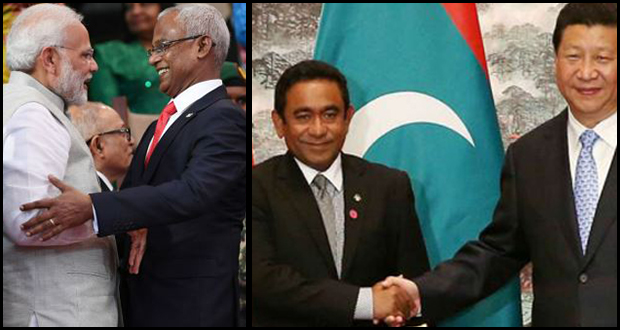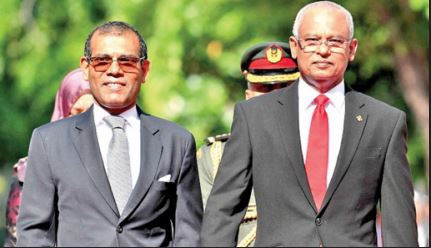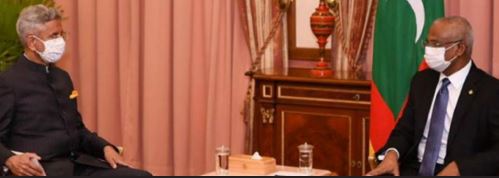Publicité
Mauritius and the battle between India and China over the Maldives
Par
Partager cet article
Mauritius and the battle between India and China over the Maldives

Former president of Maldives, Abdulla Yameen, undergoing a graft trial, has formally thrown his weight behind a campaign to eject the Indian military out of Maldives pitching the pressure on an already embattled pro-India government. Maldives is threatening to slip out of India’s orbit once again just as Mauritius is joining an India-led security organization in the region. Here is how Maldivian politics has become a proxy fight between India and China, and why New Delhi looks like it is in trouble.
- The trial
On the cusp of the New Year, the Mauritian government took a far-reaching decision: on December 30, the cabinet decided that Mauritius would formally join the Colombo Security Conclave composed of India, Sri Lanka and Maldives to boost regional security. “People don’t realize what a shift this is and that it was announced over the new year, most would have missed it,” says Milan Meetarbhan, Mauritius’ former permanent representative at the UN, “since just after independence, Mauritius has always stuck to a policy of non-alignment and neutrality, but joining this conclave shows a major commitment to a particular foreign policy and a new orientation for Mauritius.” The trouble is that Port-Louis seems to be joining the conclave, that looks aimed at countering Beijing’s influence amongst the island-states in the region, just as another one of its original members – Maldives – threatens once again to shoot out of New Delhi’s orbit, taking the newly relaunched conclave down with it.
Maldives’ ex-president Abdulla Yameen, who ruled the country between 2013 and 2018 is currently facing trial for allegedly accepting bribes and for money laundering in is of significance for Maldivian and regional politics given that Yameen has emerged as a trenchant critic of New Delhi’s influence in Maldives and has become the public face of a campaign to eject Indian military from Maldives. The problem in Maldives shows just how far India has lost its dominance on the island-state, that it could previously take for granted. After all, India was one of the first states to establish diplomatic relations with Maldives when it became independent in 1965. But its influence in Maldives did not grow until the 1970s, when the country had been dependent on Sri Lanka for trade, banking and exporting its dried fish.

Sensing an opportunity to prise Maldives away from Colombo and turn it into its own orbit, Indian Prime Minister Indira Gandhi visited Maldives in 1975. Although the gifts she bore seemed meagre – $500,000 to set up a fish cannery and help build 19 school buildings – she was accompanied by the Indian warship that stayed off the Maldivian coast during her visit. New Delhi was now to be Maldives’ security guarantor, propping up Maldivian strongman Maumoon Abdul Gayoom during his long rule from 1978 to 2008. The security relationship peaked after 1988 when New Delhi prevented a coup attempt (Operation Cactus) by 80 militants from the Sri Lankan Tamil nationalist group, PLOTE, looking to overthrow the Gayoom government in return for turning Maldives into an operations base against rival Tamil nationalist group (LTTE) and the Buddhist-dominated government in Sri Lanka.
Eventually Gayoom fell in 2008 because of the opposition led by the MDP of Mohamed Nasheed who capitalised on Gayoom’s financial mismanagement: in his last year in power alone, Gayoom spent $117 million in infrastructure contracts raking up a budget deficit of $109 million with government debt reaching $445 million – or 60 percent of GDP, making Maldives one of the most debt-laden countries at the time. When Nasheed replaced the Gayoom regime in 2008, the special relationship with India remained unchanged. The trouble was that despite his criticism of Gayoom, Nasheed proved no more capable of resolving Maldivian economic troubles; public sector salaries were increased by $78 million, and the government ‘borrowed’ $187.5 million from its central bank fuelling inflation. India tried to step in and pledged over $100 million in loans to help tide the government over, but by 2012, Nasheed was forced out of office in a ‘coup’ and protests over his own econo- mic mismanagement and his harsh crackdowns on opposition protests. Elections held in 2013 brought Abdulla Yameen and his PPM to power.

- The tilt towards China
The Yameen years marked a shift in Maldivian politics and the breaking of the special relationship between India and Maldives. The new Yameen government turned towards Beijing. Maldives’ strategic position had put it on the radar of both New Delhi and Beijing: half of India’s foreign trade and 80 percent of its energy imports transit through sea lanes near Maldives, as do China’s oil imports from the Middle East that make up 62 percent of its total imports. So, Yameen formally took Maldives into the China’s Belt and Road Initiative (BRI) and Beijing began a slew of infrastructure spending in Maldives. “Maldives stood to benefit a lot from the BRI and Chinese investments and that is what sparked the tussle between India and China there,” says Vijay Makhan, former Mauritian foreign secretary and former deputy secretary general of the AU. The Yameen government, according to former Mauritian foreign minister Arvin Boolell, “just did not have the same close relationship with the Indians. Maldives was looking for financing and China was going out of its way to extend financial support. India was left behind.”
The showpiece of Chinese spending was the China-Maldives friendship bridge to connect the main island of Malé with the island of Hulhumalé – an unfulfilled old campaign promise by Gayoom in 2008 to try to resolve Malé’s overcrowding problem by encouraging residents to move to Hulhumalé, created out of reclaimed land. The $200 million bridge was built with $116 million in grants from China, $72 million in loans and the rest paid by the Maldivian government. Another major contract was the expansion of Maldives’ international airport, after the Yameen government tore up a previous contract signed with Indian firm GMR Group.

Other projects included building a 25-storey apartment complex, a hospital and leasing an uninhabited island – Feydhoo Finolhu – to Chinese developers to build tourism infrastructure. The budding links between Maldives and China saw Chinese tourism to Maldives reach 306,000 arrivals in 2017, the same year that it signed a free trade agreement with Beijing. Just to show how complicated things can get in Mal- dives, this turn towards China was done by Yameen, an estranged brother of former strongman Gayoom, who between 2005 and 2008 held cabinet posts (first as minister of higher education, then of tourism and civil aviation) of the staunchly pro-India Gayoom regime.
The growing Sino-Maldivian links “raised eyebrows in India given its location that only deepened suspicions that it was becoming part of China’s string of pearls around it.” argues Makhan. Predictably, the bloom in relations with China meant a downward spiral with India. In 2016, the Yameen government demanded that India take back two Dhruv Advanced Light Helicopters given in 2010 and 2015 and based on the Addu Atoll and Hanimaadhoo. The idea was to eject the Indian navy and coast guard personnel based on Maldives to run the helicopters. By 2018, as protests swelled against the Yameen government, former president Nasheed called for an Indian military intervention in Maldives, with calls within New Delhi growing for some sort of action against Yameen. To dissuade an Indian intervention, China sent 11 warships in the Eastern Indian Ocean with China’s semi-official Global Times warning in an editorial that “if India one-sidedly sends troops to the Maldives, China will take action to stop New Delhi. India should not underestimate China’s opposition to unilateral military intervention”.
- Turning back to India
Ultimately, it was not the Indian military, but the 2018 elections that dislodged Yameen from power with Ibrahim Solih, handpicked by Nasheed and the MDP as their presidential candidate winning 58 percent of the vote and the MDP winning a parliamentary majority in legislative elections in 2019. After his victory, Solih declared that “India first policy is my foreign policy”. Boolell argues that “with the departure of Yameen, the new president once again developed a close relationship with India giving India the upper hand in what India considers to be part of its backyard”. “It’s like the teeth of a saw”, insists Makhan, “it’s more a question of which political party holds sway, when the government changes, so does the foreign policy.”
New Delhi was quick to try to displace Beijing: it announced a $1.4 billion line of credit and budget support to Maldives and in August 2020 its foreign minister, S. Jaishankar, announced that India would help build a $500 million bridge connecting the main island of Malé with the islands of Villingili, Gulhifahu – where India is helping build a port – and Thilafushi, which Malé wants to turn into an industrial zone. Out of the $500 million, $100 million is a grant from India while the remaining $400 million is through loans over 20 years. In October 2020, the US also announced that it would be opening the first ever US embassy in Malé. Then in February 2021, India and Maldives announced a deal to build a harbour in Uthuru Thila Falhu (UTF) under a deal that remains under wraps. At the same time, India offered Maldives a $50 million line of credit to buy defence wares from India while offering Mauritius a $100 million line of credit. The Solih government has also raised the possibility of scrapping its free trade deal with Beijing.
Now what does all this have to do with Mauritius and its signing on to the Colombo Security Conclave? A lot, as it turns out. The Colombo conclave – made up of India, Sri Lanka and Maldives, was originally established in 2011. But it was put into the deep-freeze over the Yameen government’s pro-China tilt in the Maldives. Now with the Maldivian government once again returning into New Delhi’s embrace, the conclave has been dusted off and relaunched once again. This time with Mauritius too as a member. Other prospective members are Seychelles and Bangladesh, but with Seychelles dumping a deal with India over Assumption Island and Bangladesh already a part of China’s BRI and turning its Chittagong port into part of the project, those prospects don’t look too promising.
- No smooth sailing
The wisdom of Mauritius in reversing decades of its own foreign policy to pick sides in a Sino-Indian competition and join a security alignment in the form of a conclave is fraught with uncertainties. None the least because of the fact that if politics in the Maldives was the reason it was shelved the last time round, it looks like it may soon be heading that way again. New Delhi perceived to be picking favourites in Maldives is now fuelling a series of protests there. “Some major players in the region would want to support particular governments on whose support they can count on as part of their own broader vision for the region,” insists Meetarbhan, “alternatively they also would not want to see a change in such governments which could tip the balance of power in the region. In many countries foreign policies and alliances are the product of a national consensus, this is not the case in Maldives.” The ‘India out’ campaign, looking to chuck out the 75 Indian military personnel stationed in Maldives to fly the Indian-supplied helicopters and a Dornier plane, started off on social media, but has quickly snowballed into something much bigger. Particularly around the secretive UTF deal that organizers of the campaign claim is an Indian effort to establish a permanent military presence within Maldives. The problem for the government is that even sections of the ruling MDP don’t seem immune from that campaign.
In July 2021, the Solih government was embarrassed after a bomb threat over Twitter against the Indian High Commission in Malé was discovered to have been made by a member of the ruling party itself. The MDP announced that it had expelled that member. Another problem is that the case against former president Yameen seems to be floundering in court; although Yameen still has to face trial for corruption in the leasing of two islands during his administration, in November the courts dismissed a similar case against Yameen and overturned a five-year conviction against him for the leasing of Gaafu Alifu Vodamulla island. Since his release Yameen has openly joined in the ‘India Out’ campaign. And Yameen is still a potent threat for presidential polls coming in 2023: in April 2021, Yameen wrested control of the Malé City Council away from the MDP in local elections. A bad sign, if you keep in mind that no less than 40 percent of Maldives’ total population lives in Malé.
The other problem is that the pro-India MDP itself seems to be splitting between Solih and former president Nasheed. Under the new government, Nasheed was made speaker of parliament, but he has used that position to push back against Solih, proposing a political reform programme to shift Maldives away from a presidential to a parliamentary system of government – something opposed by Solih – and even approaching Yameen for support. Nasheed has also announced his intention to become the MDP’s next presidential candidate for the 2023 elections, directly challenging Solih’s hold on the MDP.
Although the MDP controls 65 out of 87 seats in Maldives’ parliament, out of the MDP contingent, one-third is allied to Nasheed. In August last year, Solih was forced to remind the MDP that he still retained the support of the majority of the MDP’s parliamentarians. With the pro-China Yameen once again winning elections in Malé and transforming the ‘India Out’ campaign from a social media to a respectable political current and with the pro-India MDP divided between Solih and a Nasheed hungry for a political comeback, things don’t look too rosy for the MDP – and by extension, New Delhi – in 2023. “The politics in Maldives is fragile and fractured right now,” says Boolell. Should Maldives once again slip out of India’s orbit and swing once again towards Beijing after 2023, forcing New Delhi to mothball the Colombo Conclave once again, it would put Mauritius into a tight diplomatic spot.
And that too would mean diminishing diplomatic benefit for Mauritius. On its own two most pressing foreign policy questions: Chagos and the ongoing maritime dispute with Maldives over the northern maritime boundary of the Chagos, New Delhi has been less than full-throated in its support for Port Louis. On the Chagos because of its growing proximity with the US to balance against China and on the dispute with Maldives for fear of offending either of two pro-India governments in the region. “If our own core national concerns have not been reciprocated, if China has not threatened Mauritius,” asks Kee Cheong Li Kwong Wing, of the China-Mauritius Friendship Association, “why should Mauritius continue to stay out of the BRI and why should it start revising its own traditional foreign policy of non-alignment and being friends with everyone to now start taking sides, drawing lines in the sand and making enemies for no real benefit to its own national interests?”
Publicité
Publicité
Les plus récents






